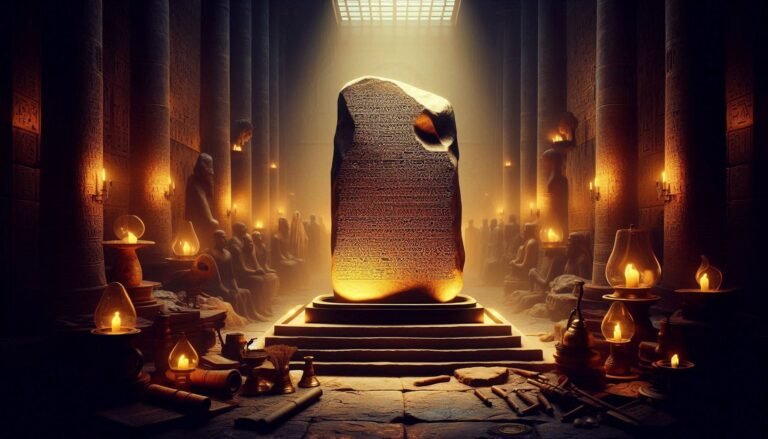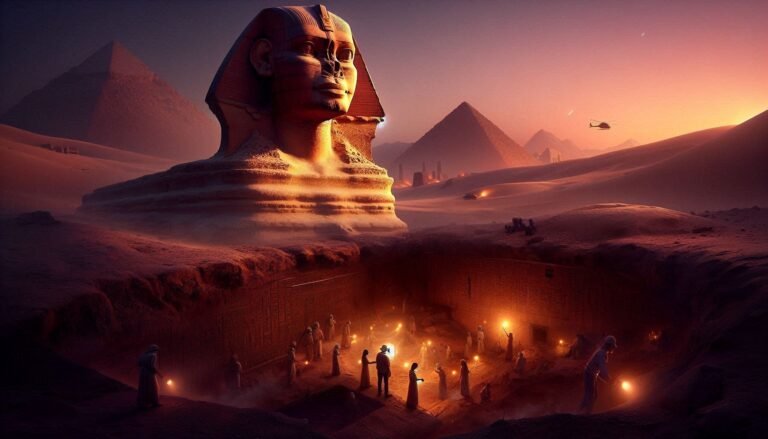INTRODUCTION
“Every beginning has an ending, and every civilization has its collapse”. This proverb rings ominously true when one considers ancient Egypt, one of the world’s oldest and most enduring civilizations, which saw its power and glory gradually ebb away over centuries. The land of the pharaohs, the pyramids, and the mighty Nile River, Egypt stood as a testament to the ingenuity and determination of man. Yet, it too succumbed to an inevitable wane. The question that has intrigued historians and Egyptologists alike is, what led to the collapse of Ancient Egypt?
HISTORICAL BACKGROUND
To illuminate the factors behind Egypt’s decline, we must first traverse back to its times of grandeur, beginning around 3100 BC with the unification of Upper and Lower Egypt by King Menes. Flourishing under dynasties that built architectural marvels and developed complex administrative systems, Egypt reached its zenith with the New Kingdom (1570-1070 BC). Pharaohs like Ramses II and Amenhotep III led military conquests, expanding Egypt’s territories, and advancing its culture and economy.
However, time was an unforgiving river, and the period of decline, marked by internal strife, unsuccessful wars, and foreign invasions, began around 1085 BC. The last native dynasty fell to the Persians in 341 BC, marking the end of Pharonic rule, and later followed by the region becoming a Roman province in 30 BC.
THEORIES AND INTERPRETATIONS
There is no shortage of theories explaining the decline and fall of ancient Egypt, with academia often centering the discussion around economic strain, civic unrest, and foreign invasions.
From the economic perspective, it has been hypothesized that the state became overextended during ambitious building projects and military expeditions, leading to an overburdened populace and governmental disarray. Academics like Toby Wilkinson mention the strain placed on Egypt’s economy by financing the monumental temples and pyramids which epitomized Pharaonic opulence but, unfortunately, also drained the kingdom’s coffers overtime.
The social and political landscape was marred by religious upheaval. Pharaoh Akhenaten’s religious reform, shifting worship toward the monotheistic sun god Aten, invited societal and clerical discord. This tumultuous era underscored the fragility of the society’s noble-religious balance, opening doors to instability and insurrection.
Foreign invasions sealed Egypt’s fate. The Nubians, the Assyrians, and the Persians all left their mark, but it was Alexander the Great in 332 BC whose conquest started the chronological countdown toward Egypt’s ultimate absorption into the Roman Empire.
MYSTERIES AND CONTROVERSIES
The collapse of ancient Egypt is not without its own shroud of mysteries and controversies, inviting numerous speculations. Renowned philosopher and historian, Herodotus, credits natural disasters such as earthquakes and long episodes of drought as catalysts for Egypt’s decline. These environmental events could potentially disrupt the vital agricultural system keyed on the Nile’s flood cycles, inducing societal distress. However, the actual impact of these disasters remains unclear due to a dearth of corroborative archaeological evidence.
Equally controversial is the theory that a rapid and severe change in climate may have contributed to the fall of the New Kingdom. Climate change implications include triggering famine and disease, further weakening central authority, argues Egyptologist Francis Breyer. Yet, the exact ramifications of climate variables on ancient Egyptian society remain contested.
SYMBOLISM AND CULTURAL SIGNIFICANCE
Though entering a stage of decline, Ancient Egypt retained significant symbolic status in the Mediterranean world, a cultural beacon of majestic architectural innovation, profound religious ideology, and ancient wisdom. Its collapse, was not, as often construed, a sudden cataclysm but rather gradual and agonizing.
Herodotus dubbed Egypt “the gift of the Nile,” emphasizing the river’s consistency and predictability. Thus, the decline of Egypt symbolized the end of an era of stability and predictability. The cultural shockwave of its collapse echoed across the civilization’s boundaries, further spotlighting the vulnerability of even the most enduring kingdoms to instability and decline.
MODERN INVESTIGATIONS
Modern scholarship and archaeological investigations continue to unveil details about Egypt’s collapse. The interpretation of newly unearthed texts and artifacts, along with rigorous examinations of earlier discoveries, have enriched our understanding.
Dr. Robert Ritner and Nadine Moeller at the University of Chicago’s Oriental Institute have highlighted the role of volcanic eruptions in Egypt’s downfall by correlating dated eruptions with periods of societal unrest. Likewise, bioarchaeological studies demonstrate connections between climatic changes and social upheaval.
LEGACY AND CONCLUSION
In retrospect, Egypt’s long-lasting influence has transcended its fall. Throughout centuries of dominance and decline, it gifted the world with profound cultural and intellectual components, including the hieroglyphic script, sundials, and stunning architectural feats such as the Great Pyramids and the Sphinx.
Ancient Egypt’s collapse was the consequence of a plethora of factors — internal unrest, economic stress, foreign invasions, possible environmental calamities — weaving an intricate historical tapestry that still engages scholars today. Its legacy, however, remains undiminished, forever imprinted on the scrolls of history, in the sands of its deserts, and in the heart of the Nile. The civilization may have crumbled, but its splendor continues to capture our fascination, standing as a poignant reminder of the impermanence of societal grandeur despite its seemingly invincible magnitude.






